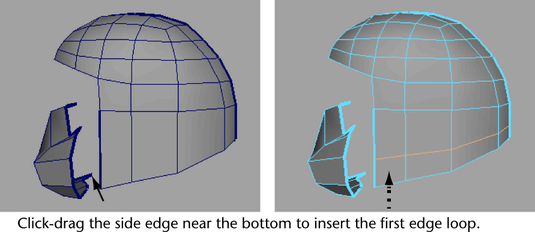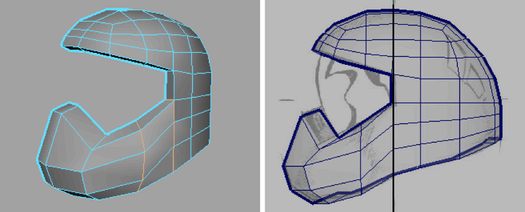Next you’ll connect the lower front region to the helmet mesh. You can create meshes that bridge between one or more border
edges of a mesh using the feature ().
When using the bridge feature you must ensure that:
- the edges to be bridged are in the same polygon mesh. That is, you must combine the two meshes into one using the feature, before you perform the bridge.
- you select an equal number of border edges on either side of the region to be bridged.
To combine the two meshes into one
- In the perspective view, right-click the mesh and select from the marking menu that appears.
- Select the helmet mesh, and then Shift-select the lower front mesh, so both meshes are selected.
- Select .
The two meshes are combined into one. When you select either object now, the other is also selected because they are in the
same mesh.
The edge of the mesh on the lower front region of the helmet is comprised of five edges. The corresponding region on the side
region of the helmet only has three. You can increase the number of edges on the lower side region by inserting two edge loops
across the mesh. Inserting two edge loops in this region of the mesh also divides the large faces so they better match the
size of the other faces on the rest of the mesh.
To insert edge loops on the side region of the helmet
- Select >
 .
.
The settings editor appears.
- In the tool settings editor, set to .
- In the perspective view, click-drag the edge on the side region of the helmet near the bottom of the edge as indicated in
the image below. Without releasing the mouse button, drag the mouse upwards about one third of the distance along the edge
and then release the mouse button to insert the edge loop.
Note
Click-dragging an edge when using the option inserts an edge loop that closely matches the existing edge layout on the mesh. That is, the lower region of the mesh
is much wider near the front than at the rear. The setting adjusts the position of the edge loop locator based on this topology so is ideal in these situations. When you click-drag
using the option, remember to click near the edge whose layout you want the edge loop to match.
- With the still active, click-drag the side region of the helmet near the top of the same edge and insert a second edge loop about
two thirds of the distance along the edge.
- Press the q key to return to selection mode, and click anywhere off the mesh to unselect the edges.
Now that you’ve inserted the necessary edges, you can proceed with creating the bridge.
To bridge between the lower front and side region of the helmet
- Choose and then click the border edges on both the lower front as well as the side region of the mesh where you want the bridging
mesh to be constructed. (You should have five edges selected on either side).
Tip
When you select border edges using the you can click on the first and last edge in a series on one side of the bridge and the tool will select the edges in between.
- Select >
 .
.
- In the window, set the to 0, then click the button to create the bridge.
- Press the q key to return to select mode, and click anywhere off the mesh to unselect the edges.
NoteIf your bridge appears to twist or cross over itself it indicates that the two meshes have their surface normals mismatched.
In this particular case it likely indicates that you did not create the original profile shape for the lower front by placing
the six vertices in a counter-clockwise direction.
If this occurs you must undo your steps to the point immediately before you combined the two meshes and then reverse the surface
normals on only the lower front section by selecting it and then selecting . You can then redo the instructions in this section as required.
 .
.



 .
.
